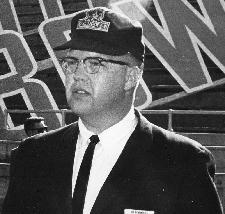
Dr. Bob Johnson
Stars of Yesterday: Dr. Bob Johnson
By Jim Joanos
A valuable member of Florida State's athletic staff at an important time in its history was Doctor Robert P. Johnson. Bob Johnson, a quiet man who rarely drew attention to himself, was the team physician for four seasons from 1962 through 65. It was during that span of time that FSU's football team under head coach Bill Peterson reached heights never before attained. The 1964 team went 9-1-1 including a first ever victory over Florida and a 36-19 victory over Oklahoma in the Gator Bowl game.
 |
Dr. Bob Johnson |
Johnson and team trainer Don Fauls worked together as a team to keep the players healthy. They were not only highly skilled but very innovative and pioneered several improvements in the training of athletes. In the sixties, the use of off-the-field training and weight work was just making its way into athletic programs. The two introduced isometrics into the training regime of FSU's athletes. They also designed and utilized various devices to help protect the athletes including a more protective facemask.
Johnson and Fauls' most heralded achievement was in the development of what was called, "Seminole Firewater." In the early sixties, there was no Powerade or Gatorade or other electrolyte drinks for athletes. In fact, some coaches did not allow their athletes to drink water during workouts or games although the medical groups had for years stated the need that the human body had for water. The misdirected coaches held on to the mistaken belief that the withholding of water made the athletes stronger. Even among teams that encouraged their athletes to consume water, sometimes the players would not drink enough water. In order to remedy this reluctance, Johnson and Fauls, with the full cooperation of Coach Peterson developed a tasty water drink that included a "1/10% salt solution with supplemental sugar for readily digestible carbohydrate" to be served "cool, but not cold." The drink was to be consumed before, during and after athletic workouts and games. The idea worked well as shown by the improved performances of FSU athletes. Johnson and Fauls apparently never thought about getting their solution copyrighted or patented as other electrolyte recipes would be later. Perhaps, they could have become wealthy as a result. Instead, they freely wrote and spoke about their creation and gave copies of the recipe to coaches and others at clinics.
Johnson played a key role in a most interesting event. As the team physician, he was expected to keep secrets. During the 1964 season in the week prior to the game against Houston, FSU's star wide receiver, Fred Biletnikoff, sustained a leg injury. Although the injury was classified as a "charley horse" it was severe enough for Biletnikoff to be put in the school's infirmary for treatment and to prevent him from any meaningful participation in the coming game. It was decided that the injury would be kept secret so that the opposing team would not have the advantage in its preparation for the game of knowing that FSU's best weapon was incapacitated. Johnson, who as the team doctor had the final say, had made the decision that Biletnikoff should not risk further injury in the game. However, he did agree to allow the wide receeiver to play one play in the game on the condition that he would not be involved in any contact during that play. This allowed FSU to list Biletnikoff among the starters in pre-game releases regarding the game. On game day, during pre-game exercises, Biletnikoff went over to an assistant coach and engaged in conversation when he otherwise would have been running routes. It looked normal enough. When the game started, Biletnikoff played the first play from scrimmage on the opposite side of the line from where the action was, after which he left the game never to return. No one will ever really know what difference the secrecy made as to the outcome of that game, but in any event, FSU and Houston tied, 13-13. The tie did not prevent FSU from later being invited to the Gator Bowl at the end of the season. Some believe that a loss to Houston would have.
Robert P. Johnson was born in 1930 in Springfield Garden, New York. He moved to West Palm Beach as a child with his family. After graduation from West Palm Beach High School, he attended Palm Beach Junior College and got a bachelor's degree from the University of Florida. He then attained his medical degree at Tulane and later did his internship at Jackson Memorial Hospital in Miami. He was a Navy physician from 1957-60. From 1960 to 62, he was the team physician for the University of Miami athletic teams including football. In 1962, he came to Tallahassee as the team physician for all of FSU's Athletic teams. In addition he served as the staff physician for the FSU infirmary. It was at the infirmary that he met his future wife and mother of his two children, Barbara. She worked there as a secretary. They were married in 1965.
After the 1965 FSU season, Johnson left the university and practiced general medicine in Tallahassee until he closed his practice in 1993. In the early seventies, for two or three years, in addition to his private practice, he served again as FSU's football team physician. He was the team physician when the Seminoles played in the inaugural Fiesta Bowl in 1971. He also continued his service as the team physician for the Florida High School football team until 1985. He had begun that duty in the sixties. He also spent a term as chairman of the medical staff at Tallahassee Memorial Hospital. From 1993 until his death in 1998, he served as a physician for the Veteran's Administration.
Dr. Bob Johnson came along at a good time for FSU athletics.